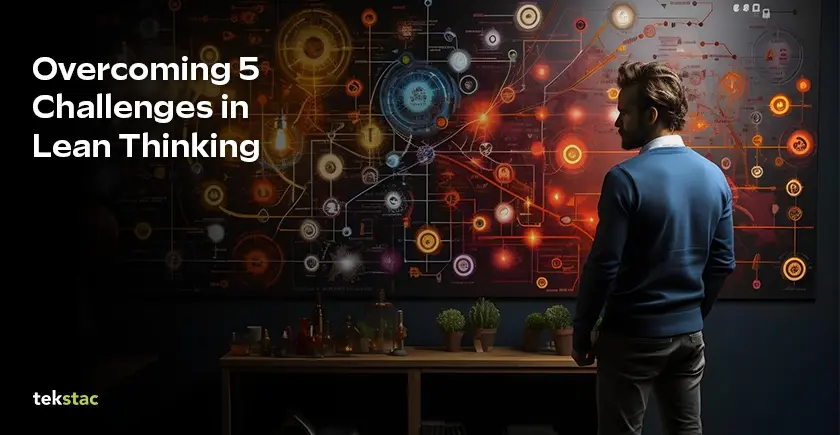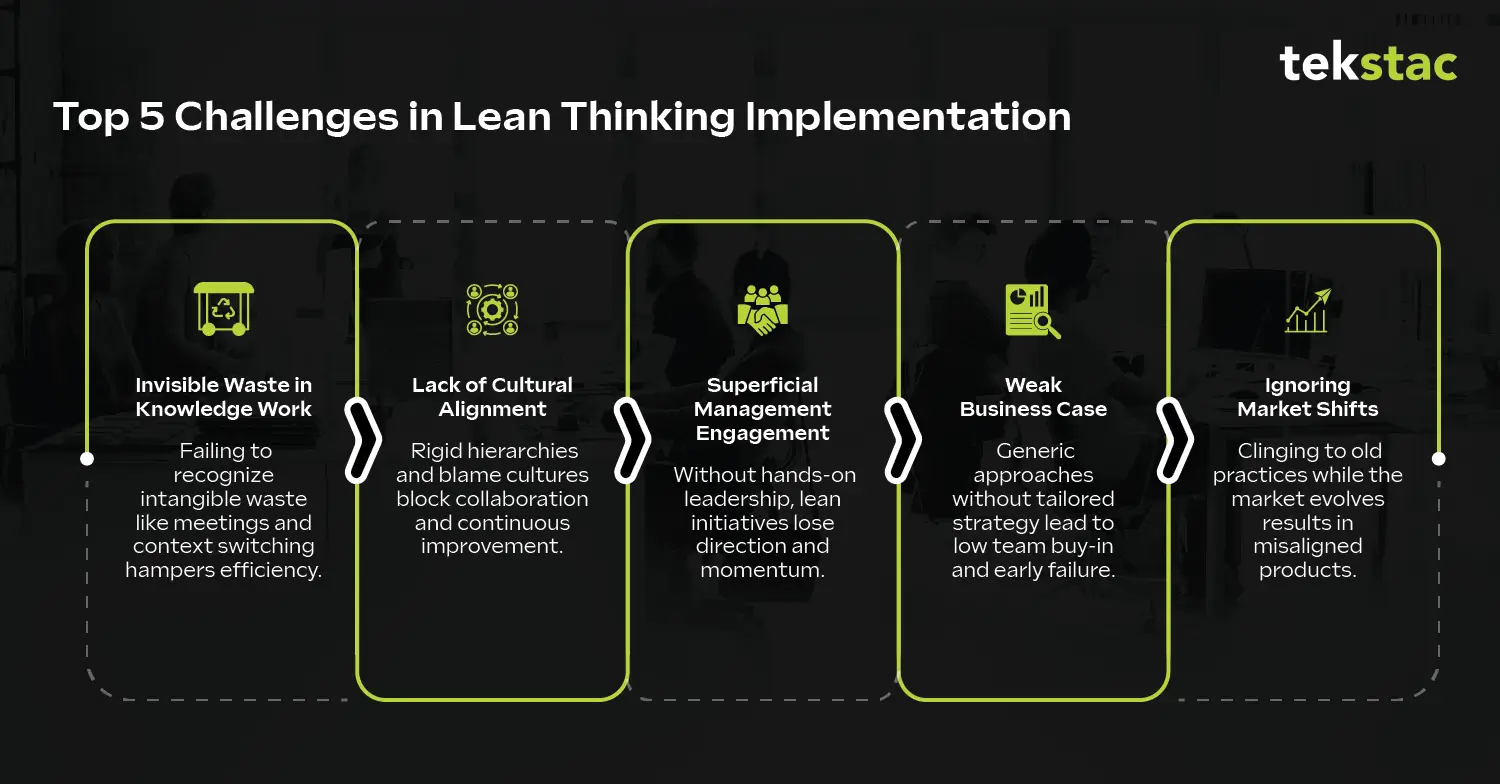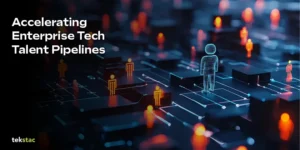Top 5 Lean Thinking Challenges and How to Overcome Them

Lean thinking promised a revolution.
Originating in Toyota’s factories, lean thinking has not only shaken up the status quo but also set a global standard for cutting waste and delivering value. It’s a movement that’s changing the way we do business.
Today, companies race to adopt and benefit from it—just like Toyota. They see waste-free processes and responsive workflows that help cut costs and respond quickly to customer demands.
However, implementing “lean” has its own challenges, as evident in the many failed implementations, with failure rates of 60–90%, similar to the 80% failure rate of organizational changes.
In this blog, we will understand the urgent need to overcome these challenges and how to implement lean thinking more effectively.
What Are the Top Challenges in Implementing Lean Thinking?
Despite its immense potential to bring in organizational revolutions through work processes and efficiency, lean thinking fails due to more profound, systemic issues from implementation challenges.

1. Misunderstanding waste in knowledge work
Lean thinking originated from Toyota Production Systems, where waste is tangible, such as extra inventory or defective products. However, in knowledge work, waste is less visible, resulting in inefficiencies like poor communication, context switching, inadequate tools, unnecessary meetings and excessive documentation.
Organizations often struggle to recognize and address these intangible forms of waste, misapplying lean tools designed for manufacturing environments. Without aligning lean practices to the organization’s nuances, companies may amplify inefficiencies and fail to eliminate waste.
For example, a software development company may implement lean thinking to reduce waste by enforcing strict time tracking—believing that the time spent on non-coding activities is wasteful. This approach backfires as brainstorming sessions and peer reviews are essential for knowledge work, and when these elements are discouraged, it may lead to lower-quality code and reduced innovation.
2. Lack of cultural alignment
Lean thinking may seem like a set of tools or methodologies, but it’s more than that—it requires cultural transformation. Hence, organizations that are not ready for change and encourage rigid, hierarchical structures fail to create an environment that supports collaboration and continuous improvement— which are needed to implement lean thinking effectively.
For example:
- Blame culture: Employees fear being held responsible for mistakes rather than learning from them
- Siloed departments: Teams operate independently without aligning on common objectives
- Low engagement: Employees lack motivation or opportunities to suggest ideas for improvement
These cultural barriers obstruct the implementation of lean principles like respecting people and creating knowledge.
3. Superficial management engagement
Lean thinking requires active and continued leadership involvement. Yet many organizations treat it as a one-time initiative rather than a permanent mindset shift. Thus, senior leaders ignore employee engagement, cascade strategies into actionable team objectives, and allocate resources for training.
Imagine a tech startup implementing lean thinking to improve its software development process. However, senior management only announces goals without directly engaging with developers or participating in daily stand-ups. Without a clear understanding, the initiative will ultimately fail because of a lack of clear direction.
4. Absence of a compelling business case
Some companies may jump ship to embrace lean implementation without understanding its relevance and context. Traditional lean training often focuses on generic benefits observed in other companies rather than developing a tailored, adjusted business case. Such lack of clarity leads to:
- Companies adopting a “let’s try it” approach instead of a committed approach
- Teams lose confidence at the first sign of difficulty, as there is no well-defined roadmap
5. Failure to adapt to market realities
Lean thinking’s principle of deferring commitment focuses on agility, but many stick to rigid planning practices. This results in premature decisions due to outdated information and products failing to meet rising customer demands. Ultimately, this leads to wasted effort and resources.
For instance, a company uses lean thinking to streamline its product development for desktop applications. However, as demand for mobile apps increases, it continues applying lean principles designed for desktop development, ignoring the shift in market trends. This results in slow market response and loss of competition.
How to Overcome Challenges in Lean Thinking
While the above challenges obstruct lean thinking implementation, they can be overcome! One key aspect is to keep in mind the principles of lean thinking, which also directly help with the above challenges:
1. Specify value by starting with the customer’s perspective
Lean thinking begins by defining value through the lens of the end customer. What exactly does the customer need, when do they need it, and what are they willing to pay for? This understanding will help set a benchmark for work processes. Think of clear communication, usable outputs, or efficient delivery timelines. Activities like context switching or inefficient tools are non-value-adding wastes.
2. Visualize and eliminate waste by mapping the value stream
To better implement lean thinking, start by defining what “waste” looks like in the environment. Organizations can begin by mapping out their work processes and looking for points where time is wasted due to poor communication or shifting between tasks. This detailed map, known as the ‘value stream,’ must also include the current and ideal states of the work process, helping visualize the flow of value better.
For example, a project management team might struggle to switch between emails and project boards. One way to cut waste is to encourage using a single, more efficient tool for fast-tracking and reducing unnecessary back-and-forth emails.
Tip: Engage employees to categorize activities as “value-adding,” “necessary but non-value-adding,” or “pure waste.”
3. Create a smooth flow for continuous progress
Lean thinking also emphasizes eliminating barriers to work. These can be overloaded team members, inefficient reviews, or other bottlenecks like unclear objectives, lack of resources, or poor task prioritization. It’s essential to keep work moving seamlessly from start to finish by identifying and addressing these constraints.
An example would be implementing strategies like Work-In-Progress limits—restrictions on the number of tasks or projects a team works on at any given time—to increase quality and ensure each task flows smoothly through the value stream. A well-managed flow will lead to faster delivery, fewer errors, and higher satisfaction for employees and customers.
It’s similar to keeping traffic on a highway below capacity. When there’s less congestion, work progresses faster.
4. Lean requires cultural alignment
Lean requires cultural alignment, but organizations with siloed departments and blame cultures may struggle. Respect for people is an essential principle of lean, which promotes trust, collaboration, and ownership of improvements.
Organizations should train managers and teams on lean principles like continuous improvement (Kaizen) and encourage them to identify inefficiencies and implement changes.
For example, in a content creation team, members can be encouraged to suggest process changes during weekly catch-ups, such as reducing revisions or clarifying ownership points.
5. Create a clear business case
Lean initiatives must start with a clear business case that links them directly to organizational goals. Without this clarity, achieving buy-in from stakeholders or maintaining long-term efforts can be challenging.
- Identify how lean thinking will address pain points like delays, errors, or costs
- Quantify the potential impact on revenue, customer satisfaction, or reduced costs
- Communicate the expected benefits using data along with real-world examples
6. Align lean initiatives with market needs
For lean thinking to have an actual impact, initiatives must align with the market’s current and future needs. This ensures that processes are optimized while prioritizing customer value, a core principle of lean thinking.
- Use interviews and surveys to understand customer pain points
- Identify touchpoints that have the most impact on customer satisfaction
- Use projects to implement changes in small batches
- Measure the impact
- Ensure all departments are aligned with market-driven priorities
7. Encourage a continuous feedback loop
One of the principles of lean implementation is iterative improvement, which requires continuous feedback. Lean thinking practices must be evaluated regularly to implement changes. One way is to use sprints to identify what worked and what did not. Customer surveys or performance metrics must validate these to drive improvements. Lastly, the focus must be on using lean thinking as a tool for growth rather than for criticism.
Driving Lean Success with AI-Powered Skilling Solutions
It’s important to note that implementing lean thinking can fail when organizations struggle with skills gaps, inefficient processes, and slow adaptation to market demands. Continuous improvement requires real-time feedback and learning. However, traditional training may fall short of amplifying lean success.
AI-powered tools, like Tekstac, close this gap by equipping the workforce with the required skills when they need them while ensuring continuous improvement. With such tools, organizations gain real-time skill assessments, personalized learning paths, and instant feedback loops—all in one solution.
Tekstac is one such solution for tech talent, which can be easily integrated with lean strategies. With features like auto-evaluated labs, on-demand mentorship, and scalable training solutions, Tekstac empowers teams to adapt and stay ahead of market demands.
Hence, organizations can deliver more value faster.
Lean Thinking Challenges FAQs
1. Why does lean thinking often fail in modern organizations?
It often fails due to cultural misalignment, lack of leadership support, and misapplying tools not suited for knowledge-based work.
2. How can companies identify waste in knowledge-based work?
By mapping value streams and spotting inefficiencies like context switching, poor tools, or unnecessary meetings.
3. What role does culture play in lean implementation?
A collaborative, blame-free culture enables continuous improvement and is essential for successful lean adoption.
4. How do AI tools like Tekstac support lean implementation?
They deliver real-time skill insights, personalized learning paths, and help teams adapt quickly to changing demands.





